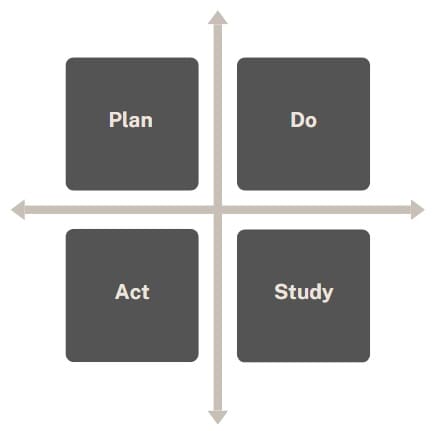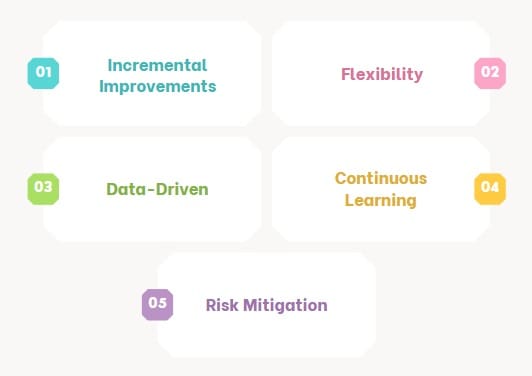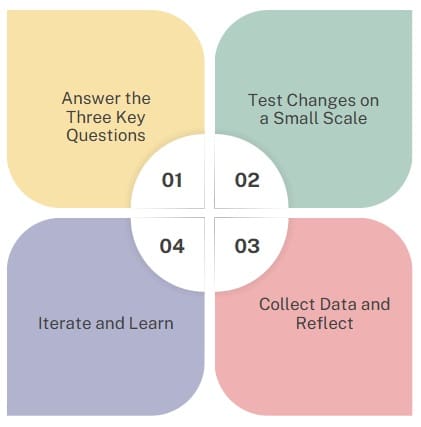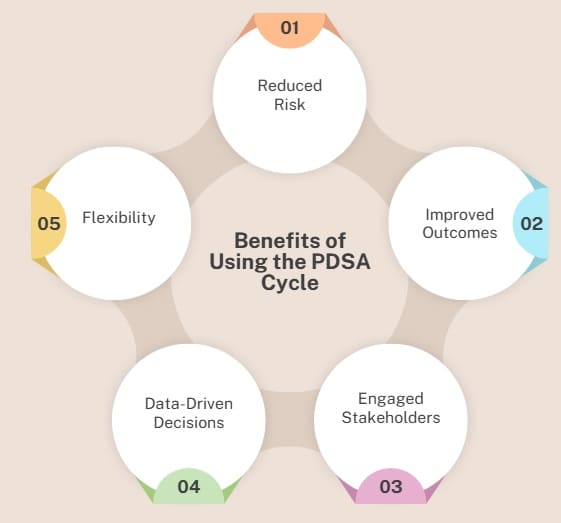The Plan-Do-Study-Act (PDSA) cycle is a core methodology for driving continuous improvement in various sectors, including healthcare, education, and business. This iterative process allows organizations to test small changes before scaling them, ensuring that improvements are both effective and sustainable.
The PDSA cycle has become a staple in quality improvement, especially when dealing with complex systems where full-scale changes can be risky without prior testing.
In this post, we’ll break down what the PDSA cycle is, how to use it effectively, and the key benefits of incorporating it into your improvement efforts.
Table of contents
What is the PDSA Cycle?
The Plan-Do-Study-Act (PDSA) cycle is an effective and flexible method used for continuous improvement in various processes, particularly in healthcare and organizational settings. This iterative problem-solving approach helps to test, measure, and refine changes in a controlled way, making it easier to adapt and improve strategies.
The PDSA cycle is particularly valuable because it encourages teams to start small, test ideas on a limited scale, and then gradually scale up successful solutions. This process promotes data-driven decision-making, learning, and adaptation, ensuring that only the most effective strategies are retained.
The PDSA cycle is a structured, scientific method designed to guide teams through the process of implementing changes in a controlled and systematic way. The cycle helps to test improvements on a small scale before fully implementing them, allowing teams to learn from real-world data and refine their ideas for better outcomes.
The PDSA cycle consists of four key stages: Plan, Do, Study, and Act. These stages are repeated as part of an ongoing process of learning and improvement.

Plan
The first stage involves planning the change you want to test. This is where you define the objectives of your improvement initiative, including what you hope to accomplish, how you will measure success, and what changes you think will drive improvement.
Key components of the Plan stage
- Setting clear goals: It’s essential to define what exactly you want to improve. For example, in healthcare, a hospital might aim to reduce patient wait times or improve the speed of diagnosis.
- Identifying measures: You need to determine how you will know if your changes are successful. This could include quantitative measures (e.g., time saved, error rates) and qualitative ones (e.g., patient satisfaction).
- Developing a plan: This involves creating a detailed action plan with specific tasks, responsibilities, timelines, and resources.
Do
The next step is to implement the change on a small scale. You test your planned change in a controlled environment with limited scope, such as one department or a select group of patients or customers. The key during this phase is to collect data and observe how the change affects your processes or outcomes.
Actions to take during the Do phase:
- Implement the change: Carry out the action plan you developed in the Plan phase.
- Collect data: Measure the relevant outcomes that will help you determine if the change is having the desired effect.
- Monitor progress: Track how the change impacts the performance of the system or process.
Study
After implementing the change, you need to analyze the data to determine if the desired outcomes were achieved. This phase allows you to reflect on the impact of the change, identify successes, and recognize any unintended consequences.
Steps to take in the Study phase:
- Analyze the data: Look at the data you collected during the Do phase. Did the change lead to the desired improvement? Were there any unexpected results?
- Compare results to predictions: Compare the actual results with what you expected. If there is a discrepancy, try to understand why and what adjustments are necessary.
- Reflect: This is the time to review the effectiveness of the change. Was it successful? If not, why? What lessons were learned?
Act
Based on your findings from the Study phase, you need to decide how to move forward. This phase involves deciding whether to:
- Adopt the change: If the test was successful, you can begin the process of scaling the change for broader implementation.
- Adapt the change: If the change wasn’t as effective as anticipated, you may need to modify it and test again.
- Abandon the change: If the change didn’t work at all, it may be best to discard it and try something different.
The decision made in the Act phase will guide the next iteration of the PDSA cycle. If the change is adopted, the next steps involve planning its full-scale implementation. If it is adapted, further tests are needed, and if abandoned, new changes should be explored.
When to Use the PDSA Cycle?
The PDSA cycle is particularly useful when:
- You want to test a small-scale change before full implementation.
- The proposed changes are experimental and need validation.
- You are working in environments where the risks of large-scale changes can have significant negative impacts.
- You need to involve stakeholders, such as staff, patients, or customers, to refine and improve processes.
- You are managing complex systems that require iterative adjustments for improvement.
Why Use the PDSA Cycle?

The PDSA cycle offers several advantages in driving improvements:
- Incremental Improvements: The cycle focuses on making small, manageable changes that can lead to sustainable improvements over time.
- Flexibility: The cycle is adaptable to different contexts, whether the improvement is in healthcare, education, business, or other industries.
- Data-Driven: The PDSA cycle emphasizes the use of data to make decisions and track progress, which helps ensure that changes are effective and measurable.
- Continuous Learning: Each iteration of the cycle provides valuable feedback, helping teams learn from both successes and failures.
- Risk Mitigation: By testing changes on a small scale, teams can reduce the risks associated with implementing large-scale changes that might fail or disrupt the system.
How to Use the PDSA Cycle Effectively?

The effectiveness of the PDSA cycle relies on careful planning, data collection, and analysis. Here’s a step-by-step guide to help you use the cycle successfully:
- Answer the Three Key Questions
Before starting the PDSA cycle, it’s crucial to answer three guiding questions:- What are we trying to accomplish? Establish a clear aim for the improvement project.
- How will we know if the change is an improvement? Identify the measures that will help you track progress.
- What changes can we make that will result in improvement? Select the most promising change ideas to test.
- Test Changes on a Small Scale
Start with small, manageable tests to minimize risks. For instance, test the change in one department, one process, or one patient case. This allows you to assess the impact before broader application. - Collect Data and Reflect
Data is essential in determining whether your changes are effective. Use both quantitative data (e.g., time saved, error rates) and qualitative feedback (e.g., user experience, patient satisfaction) to gauge success. - Iterate and Learn
The PDSA cycle is not a one-time process. After each cycle, analyze the results, make adjustments, and then test again. Continuous improvement is key to achieving long-term success.
Benefits of Using the PDSA Cycle

The PDSA cycle offers several advantages, particularly in dynamic environments like healthcare:
- Reduced Risk: By testing changes on a small scale, you can identify potential issues before they affect the larger system.
- Improved Outcomes: The iterative nature of the PDSA cycle allows for gradual improvement, building confidence in changes over time.
- Engaged Stakeholders: Involving staff, patients, and other stakeholders in the improvement process increases buy-in and ensures that changes are practical and effective.
- Data-Driven Decisions: The focus on data collection and analysis ensures that decisions are based on evidence, not assumptions.
- Flexibility: The PDSA cycle allows for adaptation and refinement of changes, ensuring that improvements are both effective and sustainable.
Also Read: Lean Six Sigma Certification Programs, Gilbert, Arizona
Key Considerations for Using PDSA
Team Involvement: The PDSA cycle works best when the team is actively involved in each phase of the process. It is essential to have the right mix of stakeholders, including experts, decision-makers, and those directly affected by the changes.
Clear Measurement: To assess whether changes lead to improvement, teams must establish clear metrics at the beginning of the cycle. These metrics should align with the improvement goals and be measurable over time.
Iterative Nature: The PDSA cycle is iterative, meaning that teams may need to go through several cycles before achieving the desired results. Each cycle builds on the previous one, allowing for continuous learning and refinement.
Small Scale Testing: The key to success with PDSA is testing changes on a small scale first. This reduces the risk of implementing widespread changes that might not work as expected.
Example: Implementing Teach-Back for Patient Communication
To illustrate the PDSA cycle in action, let’s consider a healthcare example. A team wants to test a communication method called Teach-Back with patients. In Teach-Back, the patient is asked to repeat back the information they were given, ensuring that they fully understand their care plan.
- Plan: The team plans to introduce Teach-Back with a small group of patients. They predict that using Teach-Back will take more time initially, but that the time spent will lead to better patient understanding and reduce the need for rework. The team plans to collect data by asking healthcare providers to document their experience with Teach-Back and by surveying patients on their understanding of their care plans.
- Do: The team tests Teach-Back with three healthcare providers and their patients. The providers document their experiences, noting that one patient needed additional explanations, while others had no issues. They collect data on how much time the process took and the clarity of communication.
- Study: After reviewing the data, the team found that Teach-Back did take about five extra minutes per patient, but patients seemed to understand their care plans better. One healthcare provider, Jane, found that a patient who initially didn’t understand their medication schedule was able to explain it back correctly after a second explanation. The team learned that the medication information sheets they were using were not as clear as they thought.
- Act: Based on the findings, the team decides to continue using Teach-Back for all patients, particularly when prescribing medications. Jane plans to integrate it into her routine care, and the team agrees to revisit the medication information sheets to make them more user-friendly. They decide to test these changes with a larger group of patients in the coming weeks.
Final Words
The PDSA cycle is a powerful tool for driving continuous improvement across various sectors. By carefully planning, testing, studying, and acting on changes, organizations can make data-driven decisions, reduce risks, and ensure sustainable improvements.
The key to success with the PDSA cycle is to approach each change iteratively, learn from each cycle, and refine your processes over time. Whether you’re working in healthcare, education, or business, the PDSA cycle can help you achieve measurable and meaningful improvements.

About Six Sigma Development Solutions, Inc.
Six Sigma Development Solutions, Inc. offers onsite, public, and virtual Lean Six Sigma certification training. We are an Accredited Training Organization by the IASSC (International Association of Six Sigma Certification). We offer Lean Six Sigma Green Belt, Black Belt, and Yellow Belt, as well as LEAN certifications.
Book a Call and Let us know how we can help meet your training needs.



















